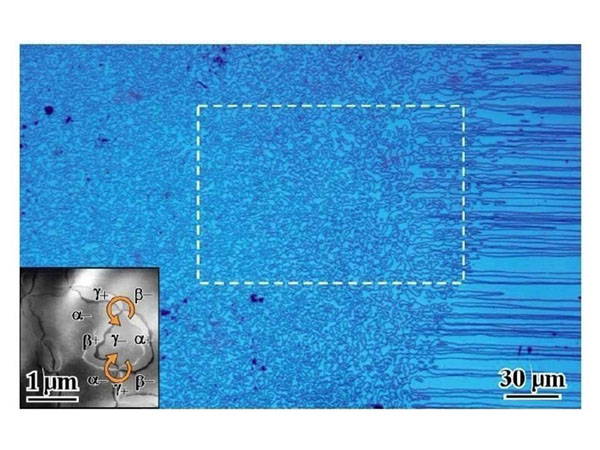Publicatie Nature Materials: Manganieten voor energiezuinig magnetisch geheugen
FOM-natuurkundige prof. dr. Maxim Mostovoy van de Rijksuniversiteit Groningen heeft een nieuw mechanisme ontdekt dat elektrische en magnetische dipolen in kristallen van hexagonale manganieten stevig aan elkaar koppelt. Door elektrische en magnetische eigenschappen op deze manier te koppelen, kan het energieverbruik van magnetische geheugendragers worden verlaagd. Mostovoy publiceerde zijn theoretische resultaten samen met onderzoekers van ETH Zurich en UC Santa Barbara op de Nature Materials-website op 27 oktober 2013.
Wanneer de elektrische polarisatie van een materiaal gekoppeld is aan een andere eigenschap, bijvoorbeeld het magnetische moment of de vervorming binnenin het materiaal, noemen we het materiaal multiferroïsch. 'Multiferroïsche materialen zijn interessant, omdat we het koppelen van elektrische en magnetische dipolen kunnen gebruiken om de richting van het magnetische moment om te draaien door er elektrische spanning op te zetten,' zegt prof. dr. Maxim Mostovoy. 'Hiermee kunnen we het energieverbruik van magnetische geheugendragers verminderen. Tot dusverre hebben onderzoekers zich gericht op magneto-elektrische koppeling in perfecte materialen. Maar het schakelen van magnetisme met behulp van elektrische spanning vereist het verbinden of vastklemmen van domeinen met verschillende eigenschappen. We hebben aangetoond dat hexagonale manganieten met verstoringen in hun kristalstructuren een voorbeeld zijn van hoe zo’n vastklemming kan ontstaan.'
Defect-patronen
Wanneer materialen worden blootgesteld aan hitte, vervorming of een magnetisch of elektrisch veld, verandert hun microscopische structuur vaak. Onregelmatigheden in het kristalrooster zijn onvermijdelijk en kunnen theoretisch beschreven worden door zogeheten topologische defecten. Wetenschappers hebben in kristallen van hexagonale manganieten complexe patronen van dergelijke defecten met drie verschillende ordeningen gevonden. Mostovoy en zijn collega’s hebben een manier gevonden om te verklaren waarom de defecten in ordeningen van elektrische en magnetische dipolen in deze materialen stevig aan elkaar vast gekoppeld zitten. Ze gebruikten de Landau-theorie om te beschrijven hoe de drie verschillende ordeningen die naast elkaar bestaan in hexagonale manganieten – distorsie van het kristalrooster,ferro-elektriciteit en magnetisme – aan elkaar zijn gekoppeld.
Ferro-elektrica
Uit experimenten bleek dat het oppervlak van de hexagonale manganieten is bedekt met prachtige 'klaverbladpatronen', welke defecten zijn in de periodieke kristalrooster-distorsie. De dichtheid van deze defecten is sterk afhankelijk van hoe het kristal is gemaakt. Mostovoy: 'Opmerkelijk genoeg induceerde de distorsie van de kristallagen van de manganieten ook een elektrisch dipoolmomen loodrecht op deze manganietlagen. Dat betekent dat de hexagonale manganieten ferro-elektrica zijn, een materiaalklasse die veel wordt gebruikt in moderne elektronica zoals sensoren, actuatoren en geheugendragers. Recent geleidingsonderzoek van anderen met behulp van piëzokrachtmicroscopie heeft aangetoond dat de elektrische polarisatie van hexagonale manganieten omkeert op het grensvlak van fasen met een verschillende distorsie. Hiermee wordt het mogelijk om de elektrische polarisatie te sturen door de distorsie in het kristalrooster te veranderen en andersom.'
Vastklemmen
'Uit experimenten blijkt dat de elektrische en magnetische eigenschappen in de kristallen binnen bepaalde temperatuurgebieden vastgeklemd worden: het veranderen van een eigenschap heeft een overeenkomstige verandering van een andere tot gevolg', zegt Mostovoy. 'Vanwege symmetrie voorspelt de Landau-theorie dat in hexagonale manganieten alleen die kristalstructuren stabiel zijn die elektrische en magnetische eigenschappen combineren.'
In de meeste multiferroïsche materialen die tot nu toe bestudeerd zijn, is de elektrische polarisatie miniem omdat deze is opgewekt door erg zwakke magnetische interacties. Om in zulke materialen de magnetische dipolen om te wisselen zijn erg sterke elektrische velden nodig. In conventionele ferro-elektrica (zoals gebruikt in elektronica) is er geen koppeling met magnetisme. Mosotvoy: 'Hoewel hexagonale manganieten op temperaturen functioneren die niet praktisch zijn voor daadwerkelijke toepassingen, geven ze wel een nieuw paradigma voor de zoektocht naar nieuwe multi-ferroïsche materialen, omdat ze grote polarisatie combineren met de sterke magneto-elektrisch koppeling van topologische defecten.'
Contact: Prof. dr. Maxim Mostovoy
Referentie
Landau theory of topological defects in multiferroic hexagonal manganites
doi:10.1038/nmat3786

Meer nieuws
-
02 december 2025
Student Menna Zahran wint Unilever Research Prize
-
27 november 2025
Vliegtuigen spotten met een radiotelescoop
